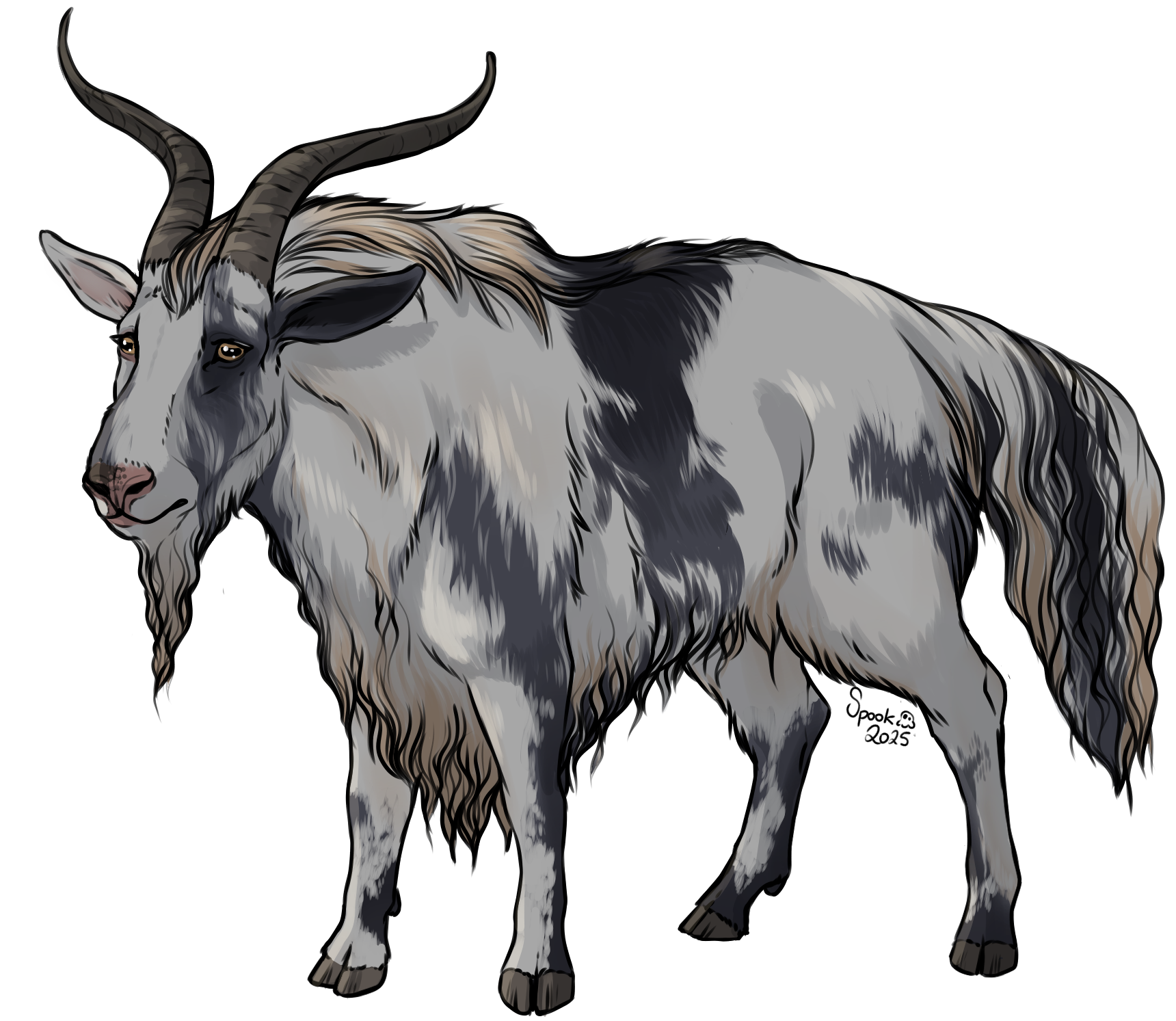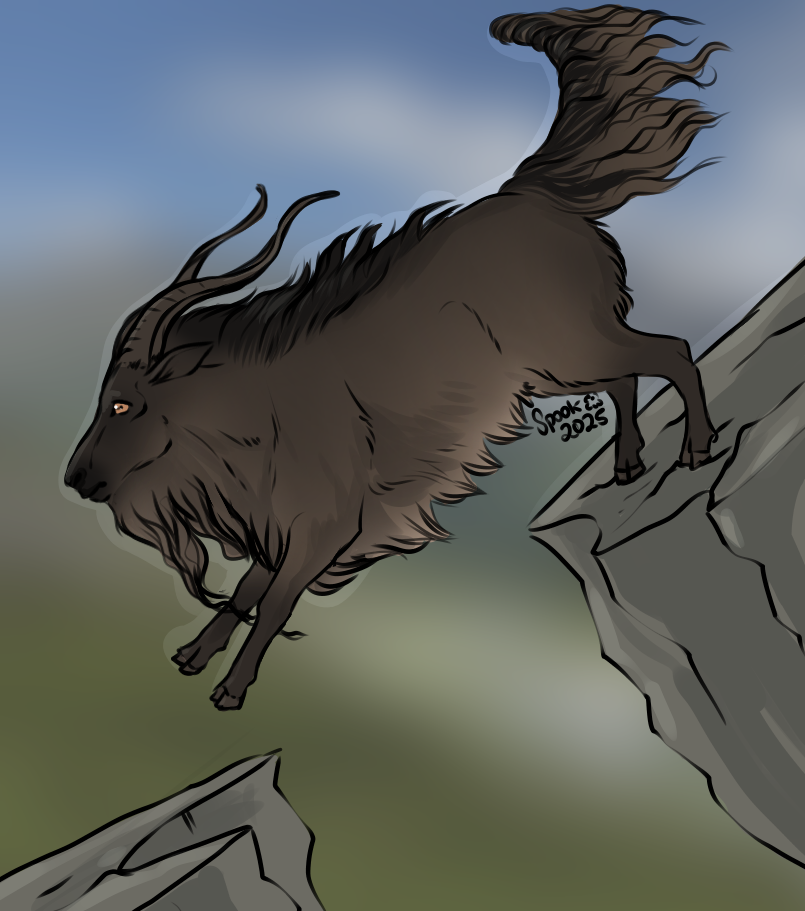Aresian Maned Goat
The Aresian maned goat is a species of herbivore native to Aresia, and present on an introduced basis in some other regions. Hardy and able to thrive in even the harshest of habitats, they are an important food source for many different cultural groups and important Aresian predators.
Description
Aresian maned goats are so named because of the thick mane that runs from between the horns to the front of the hips; a dense collection of coarse, waterproof hair designed to keep snow off of their backs.
Both males and females have twisting horns that extend sideways, though males sport a much larger set than their female counterparts. Both also have a beard, but again, the males' is a lot longer. The underside of the goat is hidden by a thick, hairy "skirt".
Stocky and with legs that look too short for their body, much of the Aresian maned goat's true shape is hidden behind their thick, curly hair. Sometimes called the "Grandfather Goat" because of their homely, frumpy appearance, they are actually incredible athletes of the animal world, with a huge density of their body weight being made up of muscle. With two toes on each foot that spread individually from one another, they can walk adeptly on both soft snow and delicate cliff edges. The back of the ankle has a small, rounded pad of rough skin, allowing them to grip the ground further in particularly rough terrain.
Standing at around a metre at the shoulder, they are impressively large goats. Females tend to be a little lighter than males, though not by much. They have a long tail compared to other goats. The tail is flexible and mobile, and is often lifted into a "flagging position as a herd moves, helping herd members keep sight on their group. The head is particularly bulky, supported by a powerful triangular neck attaching to their shoulder, creating an almost humped appearance.
The eyes are a bright amber, and the coat can be varied in colouration. Most common is a steely, grey-black, but browns and diluted creams are also common. Many have a roaned, dappled piebald pattern, causing white skin on the nose and around the eyes where the markings touch. They are also known to come in both pure black and white. It is thought that pure white goats are the result of complete piebaldism covering the base colour, rather than albinism or a similar mutation.

Piebald steel grey adult male.
Diet
Like many goats, Aresian maned goats are not picky eaters. They are herbivores, their diet consisting mostly of grass for much of the year. During winter, and in harsher climates, they happily subsist on leaves and twigs from shrubs, lichens, and mushrooms. They have complex, four-chambered stomachs and a slow digestion process that allows them to safely eat a wide range of plants and materials that would be otherwise toxic. They can happily eat wood and sticks, some poisonous fungi and thorny shrubs without much issue.
Range
Aresian maned goats are found across the entire continent of Aresia, though they are more common in harsh, mountainous climates. In rocky, cliff-like habitats, the goats can outcompete their predators because of their remarkable agility. While they are very comfortable on flat ground, grazing on grasslands, they are more easily hunted by people and predators alike, making them less common. They better thrive in cold climates, and while they can handle warmer habitats, their fur tends to become dry, brittle and matted, leading to injury and disease.
They are particularly common in the Gods' Cradle Mountains and the Mourning Peaks in Sedia, and Ei Ilmor and Allinor in Virias. There are scant populations in the Azure Isles, as well Jarrstone Island. Intoduced to Osmen in the 700 SAs, they are generally outcompeted by the native goat species, but they do thrive in remote, high-altitude mountain ranges.
Behaviour
Aresian maned goats are generally social animals, and while they can live solitarily, they tend to move in family herds consisting of anywhere between two and fifty individuals.
Flagging
The long, mobile and muscular tail of the Aresian maned goat is unique, and allows for a behaviour known as "flagging". When threatened, or moving quickly through the mountainside, the goats will elevate the tail, sometimes so far as to arch over the hips. The long, wavy hair on the tail flows well in the wind, allowing the herd to keep track of individuals through the cliffs and rocks. This is also used as a social signaling behaviour. Young goats, especially juvenile males, will stick their tails between their legs to indicate their peaceful submission. Large males will flag during breeding season, intimidating other males away from their females.
Hunting and Uses
Meat
Aresian maned goats are large and muscular. An excellent protein source for people living in remote, mountainous areas, they are a common target for hunting. Like many goats, they have a very gamey, overpowering flavour, and tend to be tough and stringy. Both of these traits are reduced by cooking the meat slowly and for a long time, and they are often made into curries, stews and braised dishes.
Aresian maned goats are a particularly important food source for the Relkish, who have hunted them for millennia to supplement their own livestock in times of harsher weather.
Pelts and Horns
The pelt of the Aresian maned goat consists of coarse, waterproof hair rather than wool or fur. This hair is comparable to horsehair, and is not particularly soft or desirable for functional clothing because of its texture. The leather is often tougher and more rigid than other common skins, such as deer or sheepskin.
Their manes, however, are often worn as a status symbol around the neck as a stole, or made into water-resistant trims and furs for outdoor use, such as on horse armour and saddlecloths. Their pelts do make quite good rugs, though the mane is often shaved down.
Similarly, the horns are too flat and twisted in profile to be used as drinking vessels or decorative candle holders. However, they are quite striking and large males can have massive horns that are quite the trophy. They are processed into knife handles, buttons, sewing needles and similar small trinkets.
Conservation Concerns
Aresian maned goats breed very readily and rapidly. Because of their ability to thrive in remote climates, they are a less common hunting target than some other large herbivores, leading to much more stable populations compared to other common trophy hunting targets. For many thousands of years, they have been considered a more ethical hunting target than some other animals, with hunters going to great lengths to track and take down a goat in the harshest of mountains. With the invention of airships, aerial hunting has become a more common pastime for wealthy individuals, leading to a more present concern about the conservation of Aresian maned goats. No protections are currently in place to legally safeguard the goats from hunting.

A large adult male, demonstrating climbing ability.
Common name: Aresian maned goat
Conservation: Least Concern
Range: Aresia, Osmen
Lifespan: 12-15 years




Love it! Also very nice art you made there, awesome. <3